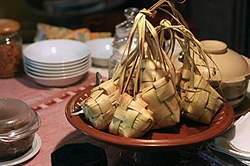
Back কেটুপাত AS Tipat BAN Katupat BJN Puso CEB Ketupat German Ketupat Spanish کتوپات FA Ketupat French Ketupat ID Ketupat Italian
 Unopened bunch of cooked ketupat on a plate. | |
| Alternative names | Kupat, tupat, topat, tipat |
|---|---|
| Course | Main course |
| Place of origin | Indonesia[1][2] |
| Region or state | Java |
| Serving temperature | Hot or room temperature |
| Main ingredients | Rice cooked inside of a pouch made from woven young palm leaves |
| Variations | Ketupat pulut, ketupat daun palas (Malay), lepet |
| 1 bowl of ketupat sayur has approximately 93[3] kcal | |
Ketupat (in Indonesian and Malay), or kupat (in Javanese and Sundanese), or tipat (in Balinese)[4] is a Javanese rice cake packed inside a diamond-shaped container of woven palm leaf pouch.[5] Originating in Indonesia, it is also found in Brunei, Malaysia, Singapore, southern Philippines, southern Thailand, Cambodia and Laos. It is commonly described as "packed rice", although there are other types of similar packed rice such as lontong and bakchang.
Ketupat is cut open until its skin (woven palm leaf) is totally removed. The inner rice cake is then cut into pieces and served as a staple food in place of plain steamed rice. It is usually eaten with rendang, opor ayam, sayur labu (chayote soup), or sambal goreng hati (liver in sambal), or served as an accompaniment to satay (chicken or red meat in skewers) or gado-gado (mixed vegetables with peanut sauce). Ketupat is also the main element of certain dishes, such as ketupat sayur (ketupat in chayote soup with tofu and boiled egg) and kupat tahu (ketupat and tofu in peanut sauce).
Ketupat is related to similar dishes in other rice-farming Austronesian cultures, like the Filipino pusô or Patupat, although the latter is not restricted to diamond shapes and traditionally come in various intricately woven designs ranging from star-like to animal-shaped.[6] An octahedron-shaped version called katupat was also found in pre-colonial Guam and the Mariana Islands, before the ancient rice cultivation in the island was replaced by maize brought by the Spanish.[7][8]
- ^ Rianti, Angelina; Novenia, Agnes E.; Christopher, Alvin; Lestari, Devi; Parassih, Elfa K. (March 2018). "Ketupat as traditional food of Indonesian culture". Journal of Ethnic Foods. 5 (1): 4–9. doi:10.1016/j.jef.2018.01.001.
- ^ Cite error: The named reference
Kompas Sejarah Ketupatwas invoked but never defined (see the help page). - ^ "Calories in indonesian food ketupat sayur". My Fitness Pal.
- ^ Sri Lestari (20 January 2015). "Tipat Cantok, Kuliner Khas Bali yang Tak Membosankan". Kompas.com (in Indonesian). Retrieved 22 January 2015.
- ^ Panca Nugraha and Suherdjoko (5 August 2014). "Muslims celebrate Lebaran Ketupat a week after Idul Fitri". The Jakarta Post. Retrieved 22 January 2015.
- ^ Nocheseda, Elmer I. (2011). "The Art of Pusô: Palm Leaf Art in the Visayas in Vocabularios of the Sixteenth to the Nineteenth Centuries" (PDF). Philippine Studies. 59 (2): 251–272.
- ^ Cunningham, Lawrence J. (1992). Ancient Chamorro Society. Bess Press. p. 140. ISBN 9781880188057.
- ^ Hunter-Anderson, Rosalind; Thompson, Gillian B.; Moore, Darlene R. (1995). "Rice As a Prehistoric Valuable in the Mariana Islands, Micronesia". Asian Perspectives. 34 (1): 69–89. JSTOR 42928340.